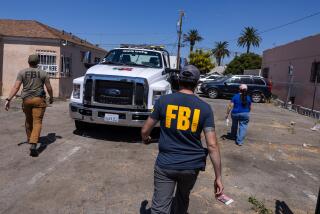Detectives crack huge L.A. art heist; 9 paintings recovered
- Share via
Nine works of art that were stolen six years ago in one of the largest art heists in L.A. history have been recovered by investigators from the Los Angeles Police Department and the FBI, according to court documents obtained by The Times.
After an undercover operation at a West Los Angeles hotel in October, federal authorities detained Raul Espinoza, 45, who tried to sell the paintings -- which are valued at $10 million -- for $700,000 cash.
The nine works recovered were among the dozen stolen from an Encino home on the morning of Aug. 24, 2008.
A thief or thieves entered through the unlocked kitchen door of a wealthy real estate investor’s home and made off with works including Marc Chagall’s “Les Paysans,” and Diego Rivera’s “Mexican Peasant.”
The elderly art collectors were in their bedrooms and heard nothing, according to the police report. At the time of the heist, the housekeeper was out purchasing groceries from Gelson’s, she told police. After returning home, the housekeeper noticed the hallway and living room walls were barren.
The case grew cold until Sept. 2, 2014, when Det. Donald Hrycyk of the LAPD’s art theft detail was tipped off to a man in Europe known as “Darko” who was soliciting buyers for the stolen works.
“[Darko] indicated that he was merely a middleman for an unknown person in possession of the art in California,” Hrycyk wrote in a search warrant obtained by the Los Angeles Times.
The FBI and LAPD set up an undercover operation, and federal authorities arrested Espinoza, who was later transferred to police custody.
Espinoza has been charged with one count of receiving stolen property, and he pleaded not guilty at an Oct. 27 arraignment, according to a spokesman for the Los Angeles County district attorney’s office.
He’s being held at the Pitchess Detention Center in Castaic on $5-million bail.
The three remaining paintings are still missing as of Dec. 1, and Hrycyk sought permission this month to search Espinoza’s Samsung Galaxy phone, believing that photos and electronic communications could bring the investigation to a close.
“I believe this information ... may reveal the identity of persons involved in the original burglary in 2008,” Hrycyk wrote in his search warrant affadavit.
For breaking news in California, follow @MattHjourno. He can be reached at [email protected].
More to Read
Sign up for Essential California
The most important California stories and recommendations in your inbox every morning.
You may occasionally receive promotional content from the Los Angeles Times.











